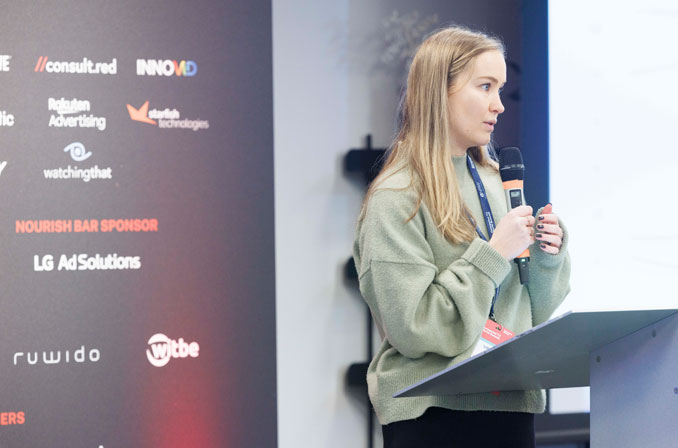Competition for eyeballs in the streaming space is fierce, and Ampere Analysis has provided some pointers on how broadcasters could increase their share of viewing time when it comes to premium digital video. Speaking at Connected TV World Summit two weeks ago, Lottie Towler, Research Manager at Ampere Analysis, outlined five strategies that could attract more viewers or get existing viewers engaged for longer. Her data focused on the UK but has clear relevance for many European markets.
The first approach is a greater focus on scripted content, with Towler arguing that BVOD (broadcaster VOD/streaming) services are underweight in this department when compared to SVODs (both for current catalogues and upcoming commissions).
She presented figures showing the proportion of UK SVOD and BVOD content catalogues that are scripted. Taken in January 2023 (from the Ampere service Ampere Analytics) these reveal that ITV has the highest proportion of scripted content among UK broadcaster streaming services, at 53%, but this is still lower than all the major SVODs.
The UK SVOD with the lowest proportion of scripted content is NOW, at 57%, while Disney+ leads with 84%. The Ampere Analysis figures show that My5 (the Channel 5 BVOD offer) has 23% scripted content, with All4 (from Channel 4) at 33% and BBC iPlayer at 45%.
Towler’s advice is that while scripted content is more expensive, it has higher engagement and better longevity. To support this, she offered the London audience a graph showing the average relative popularity of scripted vs unscripted titles in the months following release, using an Ampere Analysis Popularity Score that is a measure of relative consumer search activity levels on third-party sources such as Google and Wikipedia. This showed that scripted content begins life significantly more ‘popular’ than unscripted content and then increases that relative advantage dramatically in the months that follow.
The popularity data came from ‘Ampere Analytics, Ampere Commissioning’ (a service within Ampere Analysis) and covered the top 25 scripted titles and top 25 unscripted titles released by BBC, ITV, Channel 4 and Channel 5 for seasons released since 2018.
At launch, scripted content was around five times as popular as unscripted (based on the search activity), but at three months this was closer to 8x as popular, and at nine months it was in the region of 12 times as popular as unscripted.
With the cost of scripted content in mind, Towler demonstrated how the rate of growth for global content spend is slowing, but noted that co-commissions can be used to increase output. This is the second of her strategies to increase broadcaster share of digital viewing time.
She gave figures for the % of broadcaster scripted series that are co-commissions on a quarter-by-quarter basis. These showed regular fluctuations but a general downward trend.
For example, the highest peak for broadcaster scripted series co-commissions since Q2 2022 has been 11%, whereas there were peaks of 17% in Q2 2020 and 14% in Q1 2021. The most recent trough was 8% in Q3 2022, whereas previous troughs were 12% (e.g. Q3/Q4 2020) and 10% (e.g. Q3 2021 and Q1 2022).
Co-commissions are often among broadcasters’ most popular recent shows, Towler told the Connected TV World Summit gathering (once again using Ampere’s Popularity Score, and so based on relative consumer third-party search activity).
A diagram outlined the proportion of Top 50 popular titles in 2022 (in the UK) that were co-commissions (using the Top 50 across BBC, ITV, Channel 4 and Channel 5 – with the data again from ‘Ampere Analytics, Ampere Commissioning’). For all shows in the Top 50 during 2022, one-fifth were co-commissions. If you count only the newer content – the Top 50 shows in 2022 that were also released after 2020 – two-thirds were co-commissions.
“Co-commissions offer a cost-effective opportunity to increase the volume of premium scripted content in broadcasters’ slates,” Towler concluded.
Towler’s third suggestion is that broadcasters should take advantage of the fact that non-exclusive licensing is set to increase – meaning more studio titles will be available to license. She used HBO Max in the USA as an example, where the proportion of the catalogue that is exclusive was 80% in August 2022 but 75% in January 2023.
[The context, of course, is that when major international studios launched their direct-to-consumer ‘+’ services there was a general shift towards studios feeding their own streaming services with their own content – sometimes at the expense of third-party licensing. If studios are licensing more to third-parties again, broadcasters can boost their BVOD offer with the titles that become available.]
Towler also suggested that broadcasters can license their own content to (non-broadcaster) AVOD and FAST services to reach new audiences.
The fourth item on the ‘to-do’ list is to release more digital-first premieres, which Towler described as “key for transitioning viewers to the online platform.” Based on first-run series released in 2022, ITV is leading the way among UK broadcasters for BVOD premieres, with 7% of those first-runs going to the streaming service first. For Channel 4 the figure was 6%, with the BBC at 3%.
As well as getting linear viewers into streaming, first-run digital premieres will help draw in new audiences, she noted. Towler also advised that weekly releases on VOD help retain users and prolong engagement, compared to full-series drops.
The final part of Towler’s five-point plan is a focus on younger viewers. She had a graph showing that Netflix Originals skew younger than content on SVOD in general, and pointed out that these are backed by an aggressive social media strategy “that is key for engaging younger groups.”
Broadcasters could learn from Netflix in this regard. “A successful social media strategy across Instagram, TikTok and Snapchat can help engage this demographic,” Towler advised.


